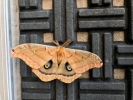
Invertebrates
See our handy guide to critters found in local homes and our Central Coast Butterfly FAQ. Browse the insects and other terrestrial arthropods we’ve identified. Check out local marine invertebrates, particularly bivalve mollusks and intertidal organisms.
- Anthropology
- Rocks & Fossils
- Invertebrates
- Vertebrates
- Botany
- Astronomy
- Fungi
- General
- Recently Asked
Is this a Polyphemus Moth?
Is this a Polyphemus Moth? I discovered this amazing moth on my front door doormat at 8:00 AM on July 30, 2019. The light above this door was on the entire night. I determined it was alive while moving the doormat to an area in the shade. The underwings opened fully. The front legs moved a bit. I made a structure around the moth to create a protective environment while leaving a space for it to crawl out if it was able to do so. At the end of the day it was still in the structure. In the morning I checked and the moth was gone.
My home is on the Riviera in Santa Barbara.
Best,
Anne


Curator Response
This is indeed a Polyphemus Moth, Antheraea polyphemus. It is in the silkmoth family (Saturniidae), and is one of the largest (up to about 6" wingspan) and most widespread species of this family, occurring throughout North America. While the adults do not feed at all, the giant green caterpillars feed on a variety of species of broad-leaved trees and shrubs. Around Santa Barbara, they probably feed mostly on Coast Live Oak, but they also really enjoy birches and elms. Like many insects, the adult moths are attracted by artificial light at night and will frequently end up on someone's porch (or on an insect collector's light sheet!). The one pictured appears to be a male. In this species, the male antennae are much more "feathery" than the female's. These antennae contain a wealth of chemoreceptors used for detecting the female's pheromones which are released during the night. This serves as an effective system to allow the sexes to get together and mate.
Best wishes,
Schlinger Chair and Curator of Entomology Matthew Gimmel, Ph.D.

